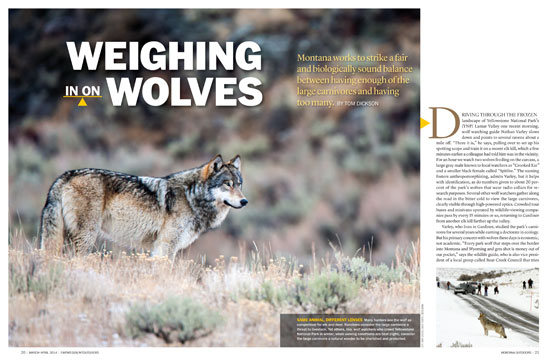MONTANA OUTDOORS
Weighing in on Wolves
Montana works to strike a fair and biologically sound balance between having enough of the large carnivores and having too many.


Trapping information coming after the October Fish and Wildlife Commission meeting
Regulations for upcoming seasons are posted online throughout the year.
All downloads below are in PDF format.
Hunters and trappers must call in their wolf harvest within 24 hours. A hunter or trapper that lawfully harvests a wolf is required to present the hide and skull to a designated FWP employee within 10 days after harvest for the purpose of: tagging the hide, tissue
sampling, and tooth extraction.
Harvest Reporting Line: 1-877-FWP-WILD (1-877-397-9453)
Report online: MyFWP
Transfer possession of harvested game animal that requires mandatory FWP inspection: Download form
These dates are provided only as a general reference. Check current regulations or use FWP's online Hunt Planner for specific dates.
Archery: Sept. 6 - Sept. 14, 2025
General: Sept. 15 - March 15, 2026
Trapping: Inside of the geographic scope identified by federal court order Jan. 1 – Feb. 15, 2026
Outside of the geographic scope identified by federal court order Dec. 1, 2025- March 15, 2026
A hunter may take up to 15 wolves per season, if at least 5 of those wolves are taken in Regions 1 or 2. A trapper may take up to 15 wolves per season on one wolf trapping license, if at least 5 of the trapped wolves are taken in Regions 1 or 2. A person may fill both their wolf hunting bag limit and wolf trapping bag limit in one season, as long as 10 (5 hunting, 5 trapping) of the 30 harvested wolves are taken in Region 1 or 2.
Trapping is authorized upon completion of a mandatory one-time wolf-trapping certification course.
Wolf Licenses are available over the counter at all Fish, Wildlife & Parks offices, License Providers, and through the Online Licensing System.
The Conservation License allows hunters, anglers, and trappers access to all legally accessible state school trust lands. Contact a DNRC office for regulations.
Wolf Mitigation Donation
When purchasing fishing, hunting, and recreation licenses, you have the option to donate to wolf mitigation. Donations will be used by the Montana Department of Livestock to contract for wolf management with the US Department of Agriculture's Wildlife Services for flight time, collaring and lethal control of wolves. Note, wolf mitigation is not a license, it is a donation.
First-time wolf trappers must successfully complete a wolf trapping certification course in Montana or Idaho before setting a trap. Learn more.
Details: With Resident Sportsman or Nonresident Combination license, 1st wolf license.
Fees:
Resident: $10
Nonresident: $25
Details: Without Resident Sportsman or Nonresident Combination license, wolf licenses 2-10.
Fees:
Resident: $12
Nonresident: $50
Hunters and trappers must call in their wolf harvest within 24 hours. A hunter or trapper that lawfully harvests a wolf is required to present the hide and skull to a designated FWP employee within 10 days after harvest for the purpose of: tagging the hide, tissue
sampling, and tooth extraction.
Harvest Reporting Line: 1-877-FWP-WILD (1-877-397-9453)
Report online: MyFWP
Transfer possession of harvested game animal that requires mandatory FWP inspection: Download form
2025 quotas:
Statewide Quota: 452
Region 3*: 60 wolves
WMU 313: 3 wolves
WMU 316: 3 wolves
* Region 3 quota of 60 is included in the statewide quota of 452
Wolf harvest status information may be obtained:
By calling 1-800-385-7826 or 406-444-1989 for statewide information
By checking the online harvest page
By checking the online dashboard
To view annual harvest reports, click here
In 2013, the state Legislature passed a law that allows landowners or their agents to take up to 100 wolves a year that potentially threaten livestock, domestic dogs or human safety (MCA 87-1-901).
The quota will be examined in four 25-wolf increments. The Montana Fish & Wildlife Commission must approve the next increment toward the 100-wolf quota.
Anyone who harvests a wolf must report it within 24 hours. To report the harvest of a wolf, call the Harvest Reporting line at 1-877-FWP-WILD (1-877-397-9453) or through MyFWP.
If you suspect a livestock loss due to wolf predation, you can request an investigation by contacting the USDA Wildlife Services: West District (406) 459-5943 or State Office (406) 657-6464.
To report a dead wolf or possible illegal activity, contact 1-800-TIP-MONT (1-800-847-6668) or a local game warden.
Gray wolves are classified as a Species in Need of Management in Montana. The state maintains sustainable hunting and trapping opportunities for wolves that follow the commitments outlined in the state's conservation and management plan.
Trapping is highly regulated, biologically sustainable, and an important part of Montana's cultural history and outdoor lifestyle.
Weighing in on Wolves
Montana works to strike a fair and biologically sound balance between having enough of the large carnivores and having too many.

Have you set up your MyFWP account?

